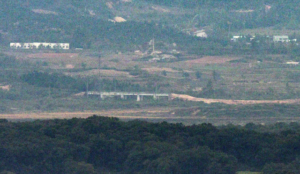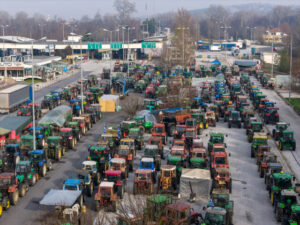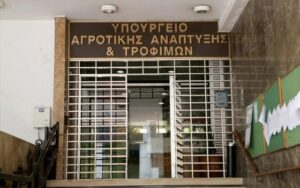The North Korean military today used explosives to destroy sections of roads once used for cross-border exchanges with South Korea, Seoul said in a new episode of rising tensions between the two nations.
“North Korea blew up parts of the Gyeonggi and Donghae roads north of the military demarcation line,” the South Korean armed forces general staff said, using official terminology for the border between the two Korean states.
In response, the South Korean forces launched “return fire” on their territory, he added without further elaboration.
The North Korean military had confirmed on October 9 that it would “permanently” cut the highly symbolic road and railway axes linking the two countries and build “strong defence structures” along the border. According to the South Korean staff, North Korea had already laid mines and barrages along the border and today did additional heavy equipment work.
In practice, the border between the two Korean states is already completely closed. Since the end of the war in 1953, the two inter-Korean roads and the two inter-Korean railroads have not been reopened except during brief periods.
In June 2020, North Korea had already blown up the Inter-Korean Liaison Office operating in Kaesong, a few kilometers north of the border, since 2018, when relations between Seoul and Pyongyang had seen an ephemeral improvement.
The destruction of these unused roads is a new manifestation of North Korean leader Kim Jong Un’s hardening policy toward South Korea, which he has said is his country’s “main enemy.”
In January 2024, Kim had also ordered the dissolution of all institutions responsible for relations with Seoul and for Korean reunification plans, and had threatened to go to war over any violation of his territory “even by 0.001 millimeter”.
According to North Korean state media, Kim Jong Un chaired a meeting of the country’s most senior military officials yesterday, Monday, and laid out the lines for possible “direct military action.”
The meeting came as the North Korean regime complained of overflights by unmanned aerial vehicles that it said dropped propaganda leaflets full of “inflammatory rumours and nonsense” on the capital and accused Seoul of being responsible.
Pyongyang warned the day before yesterday, Sunday, that if another drone was sent, it would be considered a “declaration of war.”
South Korean Defence Minister Kim Jong-hyun denied any involvement. However, the South Korean armed forces staff subsequently said it “cannot confirm whether the North Korean allegations are true or not.”
According to rumors circulating in the region, South Korean militant organizations, which are used to sending propaganda and dollars to North Korea, are responsible for these drops, generally with balloons, but sometimes with small drones that are difficult to detect.
Since May, North Korea has been sending thousands of dirt balloons to South Korea from its side, prompting Seoul to resume propaganda broadcasts via loudspeakers along the border and to suspend an agreement struck in 2018 aimed at preventing military conflicts.
In late 2022, five North Korean drones had penetrated South Korean airspace. It was the first such incident in five years and resulted in paralysis of air traffic at Seoul International Airport. The South Korean armed forces had taken off fighter jets, which had failed to shoot down any of the drones.
In July, Seoul announced that by the end of the year it would develop laser systems capable of melting the drones in flight.
After yesterday’s meeting of senior officials in Pyongyang, “the question is whether North Korea will respond by sending drones to the South or whether it will take strong measures if drones infiltrate its territory again,” explains Cheong Seong-chung, a researcher at the Sejong Institute.
“North Korea is likely to engage in serious provocations along the border if the infiltrations resume,” he predicted.
Ask me anything
Explore related questions





